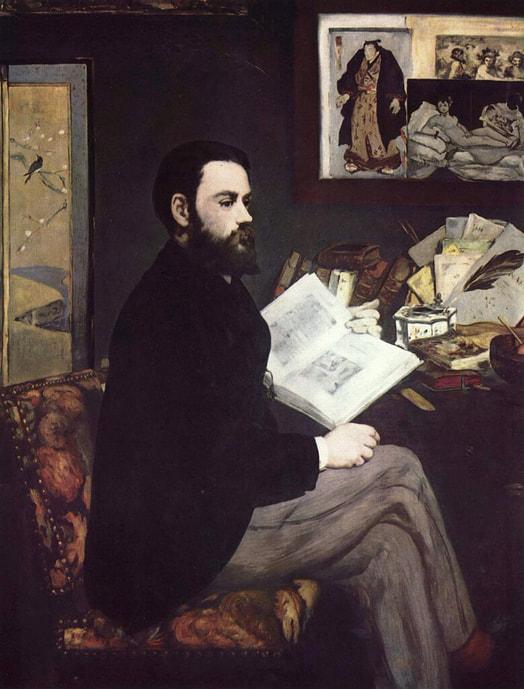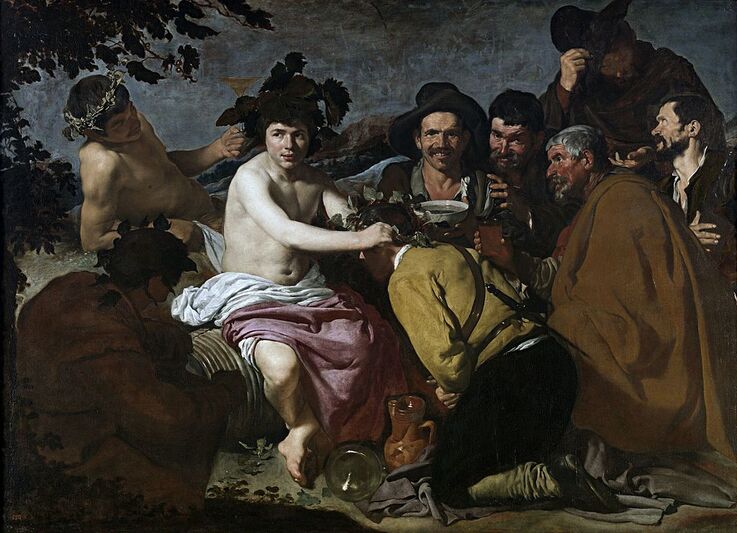|
Where? Room 14 of the Musée d’Orsay
When? 1868 What do you see? The 27-year old writer Émile Zola sits straight in a cushioned chair. He is fashionably dressed as a Parisian dandy, wearing a black jacket with grey pants. One hand rests on his knee, half-clenched. In his other hand, he holds Charles Blanc’s L’Histoire des Peintres, a book about art history. Zola seems to be in thought about something he has just read. The blankness of his expression makes the objects around him the subject of the viewer’s attention. In the background are artifacts from Japan, including an ink well on the desk, a painted screen on the far left, and a print of Utagawa Kuniaki’s Wrestler of Onaruto Nadaemon on the wall. The organized clutter atop his desk accentuates his wit and intellect. Among the books is a light blue pamphlet in which Zola defended Manet controversial painting Olympia. Directly above it is a print of Olympia herself. Behind it is a print of another famous painting, The Triumph of Bacchus by Diego Velázquez.
Backstory: In 1867, Manet had a solo exhibition. His best-known work, Olympia, was put on display for the second time. The work had received much criticism in 1865 for its avant-garde subject matter and “unrefined” style. Upon its second public display, the painting was once again the subject of many harsh comments.
Writer Émile Zola came to Manet’s defense and wrote an article in La Revue du XXe siècle. The article praised Manet’s bold style and technique, asking viewers to overlook the “risque” subject matter. Zola later published the article in its own brochure that sits on his desk in this portrait. As thanks, Manet painted Zola’s portrait. Over the course of several months, Zola posed extensively for the portrait in Manet’s studio. According to Zola, these sessions were long and exhausting as Manet did not engage in much conversation when he was painting. Manet’s main emphases in this portrait were Zola’s intellect and the aesthetics of the Far East. With the influx of Japanese goods into France in the mid-nineteenth century, many artists began imitating the flatness and simplicity of Japanese woodblock prints. This movement, known as Japonisme, was a precursor to Impressionism. Who is Émile Zola? A French writer who was born in 1840 in Paris. He is often credited as a founder of the naturalism movement in literature. He was childhood friends with Paul Cézanne who later introduced him to Manet. Zola was unemployed and lived in poverty for two years of his adult life. It was only when he published his first novel, Claude’s Confession that he was able to land a job as a journalist. Zola went on to write many more novels and published his best-known series, The Rougon Family Fortune. In the 1860s, Zola defended Impressionist artists like Cézanne, Manet, Renoir, and Monet. Who is Manet? Édouard Manet was born in 1832 in Paris where he died 51 years later. He was a Parisian Realist painter who studied in the studio of Thomas Couture for six years. Afterward, however, Manet decided against attending the official art school of the French Academy, the École des Beaux-Arts. Early on in his career, he befriended the poet Charles Baudelaire whose work featured urban outsiders such as prostitutes and street entertainers. Baudelaire’s writing inspired Manet to continue painting unusual characters alongside his other works that featured better-known figures such as musicians and writers. Manet was friends with Monet who he first considered to be a rival. He believed Monet to be copying his work. However, the pair made amends and eventually traveled to Argenteuil together. Many works came out of this trip, including Monet Painting in his Studio Boat.
Fun fact: Manet altered the print of Olympia in his portrait for Zola. Instead of facing the viewer, Olympia is looking at Émile Zola who had publicly defended her after this painting had received so much criticism at the Paris Salon (a very popular yearly art exhibition) of 1865.
Three years later, Manet submitted the painting to the Paris Salon of 1868 where it got accepted. The painting received mixed critical reviews. Some thought that the portrait was one of the best at the Salon of that year, while others thought the painting lacked animation and that it looked more like a still life than a portrait.
Written by Sabrina Tian
References:
0 Comments
Leave a Reply. |
Categories
All
|
- Home
- Blog
-
Museums
- Alte Pinakothek
- Art Institute of Chicago
- Baltimore Museum of Art
- Barber Institute of Fine Arts
- Bargello
- Barnes Foundation
- British Museum
- Church of Sant’Anastasia
- Cleveland Museum of Art
- Courtauld Institute of Art
- Detroit Institute of Arts
- Frans Hals Museum
- Galleria Borghese
- Gallerie dell'Accademia
- Getty Museum
- Guggenheim
- Hermitage Museum
- Kunsthistorisches Museum
- Kunstmuseum Basel
- Legion of Honor Museum
- Louvre
- Mauritshuis
- Metropolitan Museum of Art
- Musee d’Orsay
- Museum of Fine Arts in Boston
- Museum of Modern Art
- National Gallery in London
- National Gallery of Art
- National Museum in Poznań
- Norton Simon Museum
- Ny Carlsberg Glyptotek
- Palace of Versailles
- Palazzo Pitti
- Palazzo Vecchio
- Petit Palais
- Philadelphia Museum of Art
- Prado
- Pushkin Museum
- Ravenna Art Museum
- Rijksmuseum
- San Diego Museum of Art
- Santa Maria delle Grazie
- St. Peter's Basilica
- Städel Museum
- Statens Museum for Kunst
- Tate Britain
- Tate Modern
- Timken Museum of Art
- Uffizi
- Vatican Museums
- Wallace Collection
-
Artists
- Altdorfer
- Anguissola
- Berlin Painter
- Bosch
- Botticelli
- Boucher
- Bronzino
- Bruegel the Elder
- Brunelleschi
- Cabanel
- Caillebotte
- Canova
- Caravaggio
- Carpeaux
- Cezanne
- Cimabue
- David
- Degas
- Delacroix
- De Maria
- Donatello
- El Greco
- Fontana
- Fra Angelico
- Fragonard
- Gauguin
- Gentileschi
- Gericault
- Gonzalez-Torres
- Goya
- Hals
- Hogarth
- Hokusai
- Ingres
- Leonardo da Vinci
- Lippi, Filippo
- Longhi, Barbara
- Lorrain
- Makovsky
- Manet
- Massys
- Matisse
- Merian
- Michelangelo
- Mochi
- Modigliani
- Monet
- Panini
- Parmigianino
- Perugino
- Picasso
- Pisanello
- Raphael
- Rembrandt
- Renoir
- Reynolds
- Rivera
- Rodin
- Rubens
- Scultori
- Seurat
- Steen
- Tintoretto
- Titian
- Toulouse-Lautrec
- Turner
- Uccello
- Van der Weyden
- Van Dyck
- Van Eyck
- Van Gogh
- Van Hemessen
- Vasari
- Velazquez
- Vermeer
- Veronese
- Vigée Le Brun
-
Locations
- Books
- About Us




